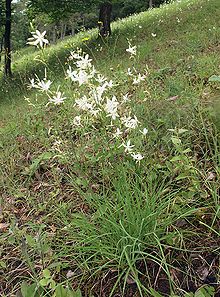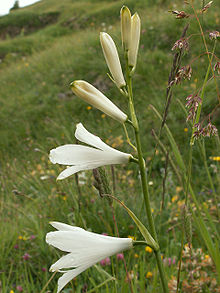Agave family
| Agave family | ||||||||||||
|---|---|---|---|---|---|---|---|---|---|---|---|---|

Dragon tree agave ( Agave attenuata ) |
||||||||||||
| Systematics | ||||||||||||
|
||||||||||||
| Scientific name | ||||||||||||
| Agavoideae | ||||||||||||
| Herb. |
The agave plants (Agavoideae) are a subfamily in the family of the asparagus plants (Asparagaceae) within the order of the asparagus-like (Asparagales). Some species are grown as ornamental plants in parks, gardens and rooms. A further use by humans is known of a few species: pulque is made from the juice of some agave types and the fibers of some agave and yucca types are processed.
description
Vegetative characteristics
There are perennial or perennial plants , there are herbaceous to shrub-like or even tree-like growing species; they form rhizomes . Few species are epiphytes . Many species are evergreen. Many species are succulents , so they can hold water. Agave and yucca are CAM plants . The shoot axes often do not reach above the surface of the soil, but in some species simple or branched stems form over many years. The leaves are alternate and spiral and usually arranged in a rosette. The leaves are always simple and have parallel nerves (never network nerves). In many species the leaves are reinforced at the edge. The stomata are anomocytic.
Generative characteristics

They often only bloom in old age, with some species dying off after the seeds have formed, i.e. they are monocarp ( Hapaxanthe plants ), but most species are polycarp. Often the simple or branched, racemose inflorescences are profuse. There are two or more bracts present, but they never completely enclose the inflorescence (differentiation of the Asparagaceae from other families of the order). The threefold flowers are mostly hermaphroditic, or more rarely functionally unisexual. There are two circles with more or less identical bloom cladding sheets; they are often free, but can also be fused to form a tube. There are two circles with three fertile stamens each, which may or may not protrude beyond the flower envelope. The three carpels are fused. The nectar secretion takes place in septal nectaries.
They usually form capsule fruits , some types of yucca form berries . The seeds are mostly flat and contain no starch. The endosperm is helobic and contains oil.
The chromosome numbers are often 2n = 24, 30. For example, Leucocrinum montanum with base chromosome numbers of x = 11, 13, 14 or Echeandia x = 8 differ.
ingredients
Saponins have been found in many taxa .





Systematics, botanical history and distribution
Taxonomy
This subfamily was set up in 1837 by William Herbert as "Agaveae". The type genus is Agave L.
Botanical history and synonyms
Molecular genetic studies in the 21st century have resulted in the family boundaries within the order of the Asparagales having shifted significantly. So the agave plants are only a subfamily (Agavoideae) in the family of the asparagus plants (Asparagaceae). Previously it was an independent family Agavaceae. The genera were earlier also in the Liliaceae Juss. incorporated. The Agavaceae family was first described as Agavineae in 1829 by Barthélemy Charles Joseph Dumortier in Analyze des Familles de Plantes 57, 58.
Synonyms for Agavoideae Herb. are: Agavaceae Dum. , Anthericaceae J. Agardh. , Anemarrhenaceae Conran, MWChase & Rudall , Behniaceae Conran, MWChase & Rudall , Chlorogalaceae Doweld & Reveal , Funkiaceae Horan. , Herreriaceae Kunth , Hesperocallidaceae Traub , Hostaceae B.Mathew and Yuccaceae J.Agardh.
Internal system
Molecular genetic studies carried out in 2006 by David John Bogler , Joseph Christopher Pires and Javier Francisco-Ortega revealed the following relationships:
|
|
|
||||||||||||||||||||||||||||||||||||||||||||||||||||||||||||||||||||||||||||||||||||||||||
|
|
Genera and their distribution
The subfamily of the Agavoideae has an almost worldwide distribution. The focus of biodiversity is in the Neotropic . The natural areas of many extend from the south of the USA , through Central America , to northern South America and Asia. Some species each occur, for example, in Malesia , northern Australia and New Zealand and on the Caribbean islands . There are also taxa in tropical to subtropical areas of other parts of the world and some taxa are also found in the Holarctic . For example, some American species made their way into southern Europe and other parts of the world through humans . Most species do not tolerate frost.
The scope of some genres has been greatly changed by revisions in the 21st century. There are about 18 genera (as of 2009) with over 600 species in the subfamily of the agave family (Agavoideae):
- Agaves ( Agave L. ): Including the former genera Manfreda Salisb. , Night Hyacinths ( Polianthes L. ), Prochnyanthes S. Watson , Pseudobravoa Rose with about 210 species from the southern United States via Mexico through all of Central America and on the Caribbean Islands to northern South America .
-
Anemarrhena Bunge : There is only one type:
- Anemarrhena asphodeloides Bunge : It occurs in northern China and Mongolia .
- Grass lilies ( Anthericum L. ): The eight or so species occur from Europe to Turkey and northern Tanzania .
-
Behnia Didr. : There is only one type:
- Behnia reticulata (Thunb.) Ditr. : It iswidespreadfrom southern tropical to southern Africa .
- Beschorneria Kunth : The eight or so species are distributed from Mexico to Honduras .
- Prairie Lilies ( Camassia Lindl. ): The approximately six species are common in eastern Canada and the United States.
- Chlorogalum Kunth : The three or so species occur from Oregon to California .
- Chlorophytum Ker Gawl. : The approximately 200 species are mainly found in tropical areas of Africa, Asia and Australia .
- Echeandia Ortega : The approximately (60 to) 83 species are distributed from Texas to Venezuela .
- Furcraea Vent. : The approximately 25 species are widespread from Mexico via Central America and on the Caribbean islands to tropical South America.
- Hagenbachia Nees & Mart. : The six or so species are distributed from southern central to tropical South America.
- Hastingsia S. Watson : The fouror sospecies occur in the western USA from southwest Oregon to northern California .
- Herreria Ruiz & Pav .: The eightor sospecies are distributed from Brazil to southern South America.
-
Herreriopsis H.Perrier : There is only one species:
- Herreriopsis elegans H.Perrier : It isnative towestern Madagascar .
- Hesperaloe Engelm. : The eight or so species occur in the US state of Texas and in northern Mexico.
-
Hesperocallis A.Gray : There is only one species:
- Hesperocallis undulata A.Gray : It occurs from southern Nevada to western Arizona and northwestern Mexico.
- Hostas ( Hosta Tratt. ): The approximately 20 species occur in Japan before and from China to the Russian Far East.
-
Leucocrinum Nutt. ex A.Gray : There is only one type:
- Leucocrinum montanum Nuttall ex A.Gray : It occurs from the western United States to northern New Mexico.
- Paradise Lily ( Paradisea Mazzuc. ): The only two species occur in Portugal , Spain , France , in Switzerland , in Italy , Austria and the former Yugoslavia before.
- Schoenolirion Torr. ex Durand : The three or so species occur from Texas to the southeastern United States.
- Palm lilies ( Yucca L. ): Including the former genera Clistoyucca (Engelm.) Trel. , Hesperoyucca (Engelm.) Trel. , Samuela Trel. , Sarcoyucca (Engelm.) Linding : The approximately 50 species are distributed in the Neotropics from the USA to Panama and on the Bermuda Islands .
swell
- The subfamily Agavoideae on the AP website. (Sections Systematics and Description) last viewed in January 2010
- Susan Verhoek, William J. Hess: Agavaceae. In: Flora of North America. Volume 26, 2002, p. 413. online (section description)
- The family of Agavaceae , the family of Anemarrhenaceae , Anthericaceae , Behniacaceae and Herreriaceae at DELTA L. Watson and MJ Dallwitz. (Description section) accessed January 2010
- David John Bogler , BB Simpson: A chloroplast DNA study of the Agavaceae. In: Systematic Botany. Volume 20, 1995, pp. 191-205 ( doi: 10.2307 / 2419449 ).
- DJ Bogler, BB Simpson: Phylogeny of Agavaceae based on ITS rDNA sequence variation. In: American Journal of Botany. Volume 83, 1996, pp. 1225-1235 ( doi: 10.2307 / 2446206 ).
- David John Bogler, JC Pires, J. Francisco-Ortega: Phylogeny of Agavaceae based on ndhF, rbcL, and ITS sequences: Implications of molecular data for classification. In: JT Columbus, EA Friar, JM Porter, LM Prince, MG Simpson (Eds.): Monocots: Comparative Biology and Evolution. Excluding poales. (= Aliso. Volume 22). 2006, pp. 313-328.
Individual evidence
- ^ William Herbert: Amaryllidaceae. Preceded by an attempt to arrange the monocotyledonous orders, and followed by a treatise on cross-bred vegetables, and supplement. Jamses Ridgeway & Sons, London 1837, p. 48, p. 57, p. 67, p. 121 (online)
- ↑ David John Bogler, Joseph Christopher Pires, Javier Francisco-Ortega: Phylogeny of Agavaceae based on ndhF, rbcL, and ITS sequences: Implications of molecular data for classification. In: JT Columbus, EA Friar, JM Porter, LM Prince, MG Simpson (Eds.): Monocots: Comparative Biology and Evolution. Excluding poales. (= Aliso. Volume 22). 2006, pp. 313-328.
- ↑ Mark W. Chase, James L. Reveal, Michael F. Fay: A subfamilial classification for the expanded asparagalean families Amaryllidaceae, Asparagaceae and Xanthorrhoeaceae. In: Botanical Journal of the Linnean Society. Vol. 161, No. 2, 2009, pp. 132-136. (Section systematics)
- ↑ a b c d e f g h i j k l m n o p q r s t Rafaël Govaerts (Ed.): Asparagaceae. In: World Checklist of Selected Plant Families (WCSP) - The Board of Trustees of the Royal Botanic Gardens, Kew .
- ^ Robert William Cruden: A Synopsis of South American Echeandia (Anthericaceae). In: Annals of the Missouri Botanical Garden. Volume 96, No. 2, 2009, pp. 251-267 ( doi: 10.3417 / 2002129 ).



